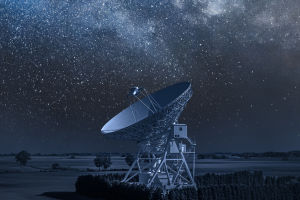Radio telescopes, as pivotal tools in humanity's quest to explore the cosmos, unveil its enigmatic mysteries.
Their uniqueness lies in the capacity to capture faint radio signals from the universe, enabling us to delve into the essence of stars, nebulae, galaxies, and other celestial bodies, unravel the laws governing cosmic evolution, and seek traces of extraterrestrial life.
This article endeavors to guide readers through the captivating realm of radio telescopes.
1. The Genesis of Radio Telescopes
The history of radio telescopes traces back to the early 20th century. In the 1920s, pioneers like Carl Zasibasi embarked on studying the utilization of radio waves for celestial detection.
Subsequently, propelled by technological advancements, the first radio telescope was erected in 1931 by American astronomer Carl Zasibasi. This heralded humanity's initial endeavors in harnessing radio technology for celestial observations.
2. The Principle of Radio Telescopes
Radio telescopes, akin to optical telescopes, operate on entirely distinct principles. They observe celestial entities by intercepting radio signals from the cosmos.
Utilizing an array of radio receivers, typically colossal dish antennas, they convert received feeble radio signals into discernible images or data. These signals emanate from a myriad of cosmic entities including stars, galaxies, nebulae, and even the cosmic microwave background radiation.
3. Classifications of Radio Telescopes
Radio telescopes are categorized based on their construction and operational mechanisms. Common classifications encompass single-aperture telescopes, interferometric array telescopes, and radio interferometers.
Single-aperture telescopes employ a solitary large dish antenna for radio signal reception, suitable for low-resolution observations.
Interferometric array telescopes utilize multiple diminutive antennas forming an array, enhancing resolution through synthetic aperture interference technology. Radio interferometers amalgamate numerous independent radio receivers to attain heightened sensitivity and resolution.
4. Achievements of Radio Telescopes
Radio telescopes have garnered numerous significant milestones in scientific exploration. For instance, in 1964, Arnold Penzias and Robert Wilson employed radio telescopes to detect the cosmic microwave background radiation, a pivotal piece of evidence substantiating the Big Bang theory.
Additionally, radio telescopes have unearthed pulsars, quasars, galaxy clusters, and other celestial phenomena, facilitating extensive research on the Milky Way's structure, interstellar matter, and beyond.
5. Future Prospects
With technological progression, the capabilities of radio telescopes are poised for continual enhancement. Envisioned are larger, more sensitive radio telescopes, alongside groundbreaking scientific discoveries. Simultaneously, as humanity delves deeper into cosmic exploration, radio telescopes will remain indispensable.
The captivating odyssey of radio telescopes is boundless. Not only do they provide a gateway to unravel the universe's mysteries, but they also kindle humanity's spirit of exploration and quest for the unknown.
With the aid of radio telescopes, the journey to comprehend the universe's mysteries and unearth astonishing revelations shall persist.


